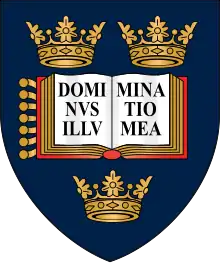Mathematical Institute, University of Oxford
The Mathematical Institute is the mathematics department at the University of Oxford, England. It forms one of the twelve departments of the Mathematical, Physical and Life Sciences Division in the University. The department is located between Somerville College and Green Templeton College on Woodstock Road, next to the Faculty of Philosophy.
| Mathematical Institute | |
|---|---|
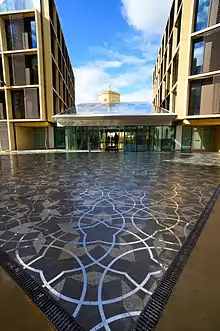 The Andrew Wiles Building, home of the Mathematical Institute at the University of Oxford and featuring the Penrose tiling at its entrance, completed in 2013. | |
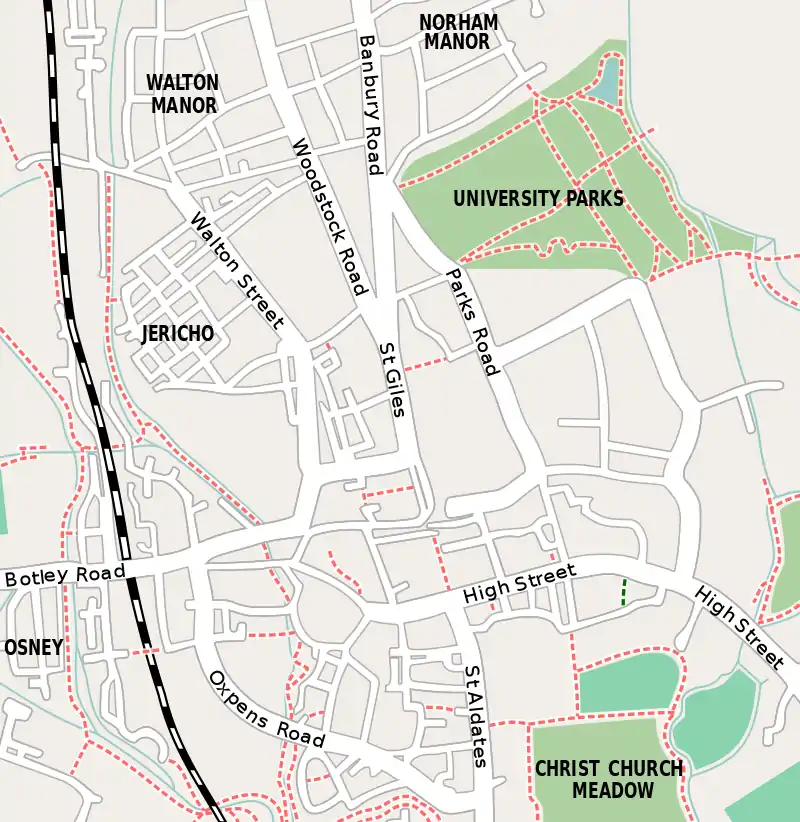 Location within Oxford city centre | |
| Alternative names | Andrew Wiles Building |
| General information | |
| Type | Academic department |
| Location | Woodstock Road, Oxford |
| Coordinates | 51.7606°N 1.2629°W |
| Completed | 2013 |
| Owner | University of Oxford |
Overview
The Oxford Mathematical Institute includes both pure and applied mathematics (Statistics is a separate department) and is one of the largest and most respected mathematics departments in the UK with about 100 faculty members, and was ranked as the top mathematics department in the UK in the 2014 UK Research Evaluation Framework.[1] Research at the Mathematical Institute covers all branches of mathematical sciences ranging from, for example, algebra, number theory, and geometry to the application of mathematics to a wide range of fields including industry, finance, climate modelling, networks and the brain. It has over 850 undergraduates, over 250 postgraduates and around 150 MSc students.
History
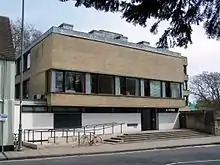
The first Mathematical Institute was built in 1966 and was located at the northern end of St Giles' near the junction with Banbury Road in central north Oxford. The building of an institute was originally proposed by G.H. Hardy at least 30 years earlier.[2] In addition, the Institute had two annexes: one in Dartington House, on Little Clarendon Street, and the other in the Gibson Building, on the site of the Radcliffe Infirmary.[3]
As of Michaelmas term 2013 Oxford Mathematics has been unified and is now housed in the purpose-built Andrew Wiles Building in the Radcliffe Observatory Quarter in North Oxford, near the original Radcliffe Infirmary. Wiles, the Regius Professor of Mathematics at the university, is known for proving Fermat's Last Theorem.[4] In 2017, the time allowed for exams was increased by 15 minutes from 90 to 105 minutes for each paper for all students, with one motivation being to improve scores of women and close the gender performance gap.[5][6]
Statutory Professors
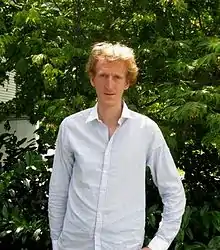

Pure mathematics
- The Regius Professor of Mathematics is Sir Andrew Wiles, KBE, FRS
- The Savilian Professor of Geometry is Dame Frances Kirwan, FRS
- The Wallis Professor of Mathematics is Terry J. Lyons, FRS
- The Waynflete Professor of Pure Mathematics is Ben Green, FRS
- The Whitehead Professor of Pure Mathematics is Martin Bridson, FRS
- The Professor of Mathematical Logic is Ehud Hrushovski, FRS
Applied mathematics
- The Sedleian Professor of Natural Philosophy is Jonathan Keating, FRS
- The Rouse Ball Professor of Mathematics is Philip Candelas, FRS
- The Professor of Mathematical Biology is Philip Maini FRS
- The Professor of Numerical Analysis is Lloyd N. Trefethen, FRS
- The Professor in the Analysis of Partial Differential Equations is Gui-Qiang Chen
- The Professor of Mathematical Modelling is Alain Goriely
- The Professor of Mathematics and Its Applications is S. Jon Chapman
- The Professor of Mathematical Finance is Rama Cont
- The Simonyi Professor for the Public Understanding of Science is Marcus du Sautoy[7]
Alumni
Sir Roger Penrose is a prominent emeritus member of the Institute. Sir Michael Atiyah was another prominent member between 1961 and 1990.[8]
In popular culture
In 2015, the final episode, "What Lies Tangled," of the British television detective drama Lewis was set and filmed in the Mathematical Institute.
References
- Research Excellence Framework 2014 ranking
- The British Society for the History of Mathematics Gazetteer, University of Warwick, UK.
- About, Mathematical Institute, University of Oxford, UK.
- "The Andrew Wiles Builkding - a Short History" (PDF). maths.ox.ac.uk. Archived from the original (PDF) on 5 September 2018. Retrieved 5 September 2018.
- Beauchamp, Sarah. "Oxford Is Giving Students Extra Time For Exams (But Female Students Especially)". Bustle. Retrieved 23 January 2018.
- Diver, Tony (2018). "Oxford University extends exam times for women's benefit". The Telegraph. ISSN 0307-1235. Retrieved 23 January 2018. Note, the title was originally "Oxford University gives women more time to pass exams", which was misleading and has since been updated.
- The Simonyi Professorship, University of Oxford, UK.
- Michael Atiyah, Some personal reminiscences. In John Fauvel, Raymond Flood, and Robin Wilson (editors), Oxford Figures: 800 Years of the Mathematical Sciences, Oxford University Press, 2000. Chapter 15, pages 257–267. ISBN 0-19-852309-2.
External links
| Wikimedia Commons has media related to Mathematical Institute, University of Oxford. |
